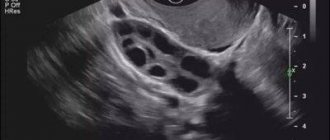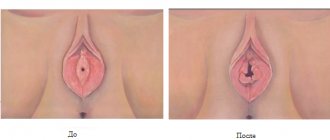Da!Zachatie
Website about pregnancy, from planning to birth
Popular
Planning a pregnancy: correctly performing an ovulation test is the key to reliability
Home › Diseases
Hormonal imbalances in the body of the expectant mother can occur for various reasons, one of which is the phenomenon of follicle persistence. What happens in this case in a woman’s body and does this condition pose a danger to her reproductive system?
- 1 What is a persistent ovarian follicle?
- 2 Symptoms and causes
- 3 Diagnosis of the disease
- 4 Treatment
- 5 Prevention
- 6 Summary
Briefly about female sex hormones
To understand the reasons for the persistence of follicles in the ovary, it is necessary to at least superficially understand how a woman’s hormonal system functions. Without understanding this process, it will be very difficult to understand the issue of the occurrence and treatment of follicle persistence.
In order for the egg to mature normally, it needs hormones. Various systems are responsible for their production in the body: ovaries, adrenal glands, pituitary gland and hypothalamus. If the ovaries produce too few hormones, the pituitary gland becomes activated. If the pituitary gland cannot cope with its duties, then the hypothalamus stimulates its work. The main female hormones include:
- estrogens;
- progesterone;
- follicle-stimulating and luteinizing hormones.
In the first half of the cycle, estrogens and follicle-stimulating hormone are especially active. It is under their influence that eggs mature in the ovary. The largest follicle containing the egg is located closest to the surface of the ovary. Such a follicle is called dominant. When it's time to ovulate, it will rupture and release an egg. She will be ready to meet the sperm. This happens normally.
During ovulation, the level of estrogen, namely estradiol, increases. Then its levels fall, but the values of luteinizing hormone begin to increase. During the same period, the process of formation of the corpus luteum begins.
The corpus luteum in the ovary produces progesterone. This hormone is necessary for the normal course of pregnancy. If it does not occur, then the level of progesterone begins to decrease, the uterine mucosa peels off and menstrual bleeding develops.
Classification
The pathology is systematized based on clinical variants of follicular persistence depending on the duration of the period during which the hormonal activity of the follicular tissue is maintained. There are two variants of the course of the disorder:
• Short-term rhythmic persistence. Develops at any age under the influence of unfavorable endogenous and exogenous factors, a mature follicle persists for 20-40 days, then menstrual-like discharge appears.
• Long-term persistence (synonym: Schroeder's disease). Peak ages 13-15 and 47-51 years (puberty and premenopause). After a long delay, follicular atresia and profuse, prolonged bleeding occur.
“Persistent follicle, what is it, is pregnancy possible?” - this question is often asked by patients to the gynecologist, but it cannot be answered unequivocally. Let's try to figure it out: is the absence of an oocyte released normal or pathological, and what measures are necessary to cope with the situation and in the future become a happy mother.
Every woman of fertile age normally undergoes changes in the reproductive system on a monthly basis under the influence of hormonal factors. Nature prepares the fair sex for pregnancy, which requires at least one fully released egg, a developed layer of the endometrium and the fusion of this female reproductive cell with the sperm. In one of the cyclic phases, several follicles mature in the ovary, but only one will dominate. It is from there that the egg will be released, and the corpus luteum will remain in the ovary for several days, providing hormonal support.
Follicle persistence
If before the upcoming ovulation the luteinizing hormone does not reach the required values, then the follicle wall does not thin out, does not rupture and the egg remains inside. This condition is called follicle persistence, that is, its long-term storage. Under such conditions, pregnancy cannot occur.
A persistent follicle does not ovulate, its membrane does not rupture and the egg cannot be released.
Depending on the hormonal background, the egg may remain immature and will be stored inside the follicle, or it may die inside it (if it has already reached maturity).
Before the onset of menstrual bleeding, the follicle is able to remain small in size. Sometimes it begins to grow (in this case, a cyst will be detected during an ultrasound). Over time, the follicle can shrink (this happens in 3 cycles, and sometimes faster). The follicle can remain in this state for many years. The woman will menstruate, but she will not be able to conceive a child. In other cases, the follicular cyst goes away on its own and does not require treatment.
If the dominant follicle has not entered the ovulation stage, it transforms into the corpus luteum and begins to produce progesterone. Such a follicle most often does not produce too much progesterone, so the woman continues to have her period. However, she will not be able to conceive a child, since normal ovulation does not occur.
When estrogen and LH levels are low, the dominant follicle does not mature at all. Menstruation in such women often also does not occur. Over time, the immature follicle resolves (atresia occurs) or undergoes reverse development. Since progesterone levels also remain at low levels, the surface layer of the uterus does not grow and is not rejected. Although, as an option, this process can occur, but it will last a very long time. In this case, the woman experiences prolonged and scanty uterine bleeding.
This video shows what a persistent follicle looks like on ultrasound:
Classification
The basic criterion for systematizing clinical options is the period during which the hormonal activity of follicular tissue is maintained. With this approach, many features are taken into account. Experts have identified two forms of pathology:
- short-term rhythmic. It can develop both during reproductive age and during menopause. Factors that provoke a failure in the production of LH and FSH have a decisive effect. In this case, a mature follicle can live for 20-40 days, after which uterine bleeding begins, reminiscent of menstruation;
- long-term Pathology makes itself felt in premenopause, since there are changes in the regulation of reproductive function. This is mainly due to atrophy of the pineal gland. It all ends with profuse bleeding.
Symptoms of follicle persistence
If the level of LH in the body remains at high levels all the time, then the egg does not mature, and the follicle transforms into the corpus luteum. Ovulation does not occur. Experts call this condition LUF or LNF syndrome. Women turn to a gynecologist with complaints about the inability to get pregnant. Patients also have menstrual dysfunction.
If a couple has been trying to conceive a child for a year, but pregnancy does not occur, then not only the woman, but also the man will need to be examined. Gynecological practice shows that LUF syndrome causes female infertility in 30% of cases. However, in order to identify it, you will need to undergo a comprehensive examination. In addition to urine and blood tests, the woman will need to have an ultrasound. This method provides information about the condition and size of the follicles. The blood must be tested for hormones. The levels of progesterone, estrogens, thyroid hormones, LH and FSH are determined.
Menstruation in women with persistent follicles becomes profuse and can occur outside of the prescribed period, that is, in the middle of the cycle. This leads to the development of anemia with a drop in hemoglobin levels in the blood. Anemia is manifested by increased weakness, increased fatigue, decreased performance, etc. Therefore, many women begin to be examined not by a gynecologist, but by a therapist. It can be difficult to suspect a hormonal imbalance on your own.
Treatment
Treatment of pathological abnormalities in the reproductive system associated with the presence of PF is carried out using special drug therapy, with the help of which hormonal balance is achieved in the body. The therapy is based on hormones, among which doctors most often prescribe Norkolut and Pregnil.
These drugs are administered intramuscularly into the body 10 days before the start of a new menstrual cycle. The course of therapy ranges from 7 to 10 days.
To reduce high levels of estrogen, which makes it impossible to conceive naturally, medications such as:
- "Tamoxifen";
- "Clomid";
- "Klostilbegit."
The course of treatment is purely individual, as is the regimen - they are indicated by the doctor based on the results of the examination of the patient.
The following procedures may be prescribed as additional therapy methods:
- gynecological massage;
- laser therapy;
- electrical stimulation of ovulation;
- procedures using ultrasonic waves.
Tracking the dynamics of treatment effectiveness is carried out by conducting monthly folliculometry and taking hormone tests.
Diagnosis of the disease
To identify LNF syndrome, a comprehensive examination will be required. Making the correct diagnosis and getting to the root of the pathology is not always easy. It is often possible to detect the persistence of the follicle only after an ultrasound or MRI of the ovaries. The remaining methods are uninformative and do not provide any specifics.
The most informative method for detecting a persistent follicle is MRI of the ovaries. It is also recommended to undergo an examination of the ovaries using an ultrasound machine.
Alternatively, persistence of follicles can be detected during diagnostic laparoscopy. This method is used not only for examination purposes, but also for treating the patient. Laparoscopy is performed under general anesthesia. Several small incisions are made on the anterior wall of the abdominal cavity through which instruments are inserted. The image is projected onto a computer monitor. If the doctor sees any pathology, he can perform the necessary surgical procedures. It is also possible to collect tissue for histological examination.
As for MRI as an examination method, it is highly informative, but technologically complex. To implement this, a contrast agent is used. In addition, the cost of MRI is several times higher than ultrasound. Therefore, to track the dynamics of the pathological process, it is the latter method that is most often used.
At the same time, ultrasound does not always provide complete information about the condition of the ovaries. The experience and qualifications of the doctor interpreting the results are of no small importance.
Folliculometry allows you to assess the age of the follicle and the process of its transformation into the corpus luteum. The shell of a persistent follicle will be dense, and fewer vessels will nourish it. The blood flow in the affected area is not as intense. Ovulation is indicated by the accumulation of fluid in the abdominal cavity. There will be little of it and it is located behind the uterus.
Luteal body cyst
In most cases, there may be an accumulation of fluid from inside the cystic cavity located where the follicle was. In this case, a cyst of the luteal body appears with a pathology of hormonal function: the level of progesterone in the woman’s blood will decrease. An unpleasant complication also often occurs. This is a rupture of a corpus luteum cyst. It will cause pain in the lower abdomen and a disturbance in the menstrual cycle.
On an ultrasound, the doctor will notice a cystic formation, the hormone progesterone will be low, the ovulation test will be positive, and your period will arrive ahead of time. Therapy involves taking pills; the doctor will prescribe the drug “Duphaston” or “Utrozhestan” to strengthen the second phase and the possibility of the desired conception.
How to treat?
In 4% of patients who seek advice from a gynecologist, persistence of follicles is detected. Against the background of endocrine infertility, these figures increase to 30%. The following factors can provoke the development of pathology:
- Genetic developmental abnormalities that are inherited.
- Inflammation of the ovaries, as well as the endocrine system.
- Poisoning of the body.
- Injuries suffered.
- Emotional shock.
The reasons why hormonal levels may be disrupted are often combined with each other. Hardening of the ovarian lining can be caused by autoimmune conditions. Hyperthyroidism and excess body weight often lead to pathology. If all these diseases are aggravated by stress, then the likelihood of hormonal imbalance increases.
Treatment is not always required to cope with pathology. Often, lifestyle changes can bring hormonal levels back to normal. To monitor the condition of the ovaries, you need to regularly visit your doctor and undergo the examinations recommended by him. If a specific cause of hormonal imbalance is identified, it will be eliminated.
Proper dietary nutrition, along with leading a normal lifestyle, can restore ovarian function. This is a fact proven by medical research.
In some cases, normalization of the daily routine and proper nutrition are the only components of therapy. For many women who have revised their lifestyle, ovulatory function is restored after 3-4 cycles.
If recovery does not occur, then hormonal medications are required. It is important to work closely with your doctor and strictly follow all his instructions.
Pregnancy may not occur
In this case, low progesterone levels may be a factor in shortening the cycle and causing hormonal imbalance. If luteal phase testosterone is regularly deficient, the following diseases may appear:
- uterine fibroids;
- advanced endometriosis;
- untreated endometrial hyperplasia;
- polyp of the uterus or cervical canal;
- ovarian cysts.
Clinical manifestations
Long-term persistence of the follicle is accompanied by endometrial hyperplasia, thrombosis of blood vessels, changes in the stroma and blood vessels.
First, amenorrhea occurs, which after 1–2 months is replaced by bleeding. Atrophied, necrotic, overgrown endometrial tissues are rejected in separate fragments, causing profuse, prolonged metrorrhagia.
There is no secretory phase in the uterine layer. Pathological proliferation gradually leads to cystic and polypous neoplasms. In the enlarged ovaries, small cysts are found from mature eggs with granular contents; there are no corpora lutea.
Infertility - as one of the signs of follicle persistence
The main signs of follicle persistence:
- infertility, pregnancy does not occur for more than 1 year;
- menstrual irregularities;
- prolonged bleeding alternating with periods of amenorrhea.
During the period of follicle growth, there are no menstruation, no metrorrhagia for more than 35 days (up to 1.5 months). Uterine bleeding occurs during the period of expected ovulation and the onset of the luteal phase of the cycle.
With short-term persistence of the follicle of the left ovary, blood loss may be insignificant and differ little from normal menstruation. The long-term type of pathology is accompanied by heavy blood loss, lasting more than 7 days.
Long-term persistence of the follicle and pregnancy are incompatible; women cannot conceive a child for more than a year, living a full sex life. Intense metrorrhagia leads to the development of hypochromic anemia.
In this case, the nervous, cardiovascular and respiratory systems suffer, patients complain of general weakness, fatigue, and dizziness. The pathology is most often diagnosed in adolescents and women over 45 years of age.
Sometimes heavy and prolonged bleeding occurs if endometrial rejection occurs in separate areas.
- Services Ovulation calculator
- Calculate month of pregnancy
- Calculate due date
- Calculate due date after IVF
- Test calendar
- Test cost calculator
- Calculate gestational age
- Calculate the effectiveness of IVF
- HCG calculator
- Decoding the spermogram
- Self-diagnosis
- Menstrual cycle calendar
Follicle persistence is the presence of a leading follicle in the ovary throughout the menstrual cycle.
Question to a specialist
Practicing obstetrician-gynecologist Natalya Yuryevna answers the questions:
- I am 22 years old and my period has been late for 10 days. I took a pregnancy test, the result was negative. The doctor sent me for an ultrasound, the results of which revealed persistence of the follicle in my left ovary. What does this mean and what to do next? Answer : with a persistent follicle, the egg grows, but does not come out, since the walls of the follicle do not rupture. Often, against the background of such a disorder, there is a delay in the menstrual cycle. Provided that such a situation occurs no more than twice a year, no measures should be taken. If failures occur regularly, you need to undergo an examination and identify their cause. Otherwise, getting pregnant will be problematic. You should wait until your period and then have another ultrasound. It is performed on days 16-20 of the cycle.
- I am 30 years old, I want to become a mother. I had an ultrasound, during which a follicle was discovered (the study was carried out on the 16th day of the cycle). Its size was 22 mm. The ultrasound was repeated on day 19. It decreased by 2 mm. What next steps to take? Answer : folliculometry will need to be repeated next month. I also recommend that you do an ovulation test (you can buy it at the pharmacy). If ovulation has not occurred, then you need to be examined further. It is important to assess the level of hormones in the blood. After this, the doctor will give you specific recommendations.
Diagnostic measures
A doctor may suspect a diagnosis when a patient complains of menstrual irregularities, delayed menstruation, or lack of a desired pregnancy. It should be noted that such symptoms are non-pathognomonic and can accompany a number of other gynecological diseases, therefore the final diagnosis is established after an examination. The diagnostic algorithm includes:
Prevention
There is no way to prevent this disease. True, there are a number of recommendations, following which you can minimize the risk of developing pathology:
And if your relatives have had documented hormonal imbalances, which can be transmitted hereditarily, then following all the recommendations described above and regular examinations by specialists will help reduce the risk of developing any abnormalities in the functioning of the endocrine system.
A condition such as persistence is a serious pathology, which without proper attention and timely treatment leads to infertility. But be that as it may, this pathological deviation is not a death sentence. The main thing is not to start it and not to allow the persistent germ cell to develop into a cyst.
Regular monitoring of your health and maintaining a correct lifestyle will help prevent unwanted consequences of the disease.
Have you ever encountered a similar problem? Perhaps one of your friends shared similar experiences? Was the treatment successful and did you manage to get pregnant after that?
Source










